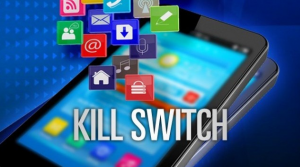Kill Switch May Finally Come to the U.S. Consumers
What It Does
Kill switch is the in-built feature available by default in iPhones, and Samsung introduced find my mobile and reactivation lock as an alternative just because the U.S. carriers would not allow the South Korean company introduce the very kill switch.
If you run the misfortune of having your smartphone stolen, you can lock the device remotely by calling the wireless carrier or navigating to a specific website to send your device command to kill your private data or simply lock your device. According to the US lawmakers “the kill switch renders the device inoperable on the network of any provider of commercial mobile service or commercial mobile data service globally, even if the device is turned off or has the data storage medium removed.” Only the owner would know the password to remove the lock, unlock the personal data and make the device operable again.
Samsung and the Kill Switch
Back in January 2014 Businessweek wrote about Samsung Kill Switch being blocked from the US market by the US carriers. The South Korean manufacturer faced unbelievable counteraction from wireless carriers in introducing the kill switch in new Samsung devices. Verizon, Sprint, US cellular, T-MOBILE mobile and AT&T found the kill switch feature introduced by Samsung as a potentially heavy burden for their customer service departments. There is some truth to it since troubleshooting mobile devices is generally a problem of wireless carriers, and not the manufacturers, so the setup and reactivation of kill switch for accidentally locked devices may in fact add some extra weight on technical support of the carriers.
CTIA, the lobbying organization of wireless carriers, was developing another theft preventing project to help Police find stolen phones, which resulted in a phone tracking database that launched back in November 2013. However, even though this program helps police to track phones that are not, in fact, stolen, it doesn’t help users find stolen phones or lock the devices when they are stolen.
“The main goal for carriers is to keep support costs low and encourage subscribership, so antitheft technology could cause support nightmares,” said research director for Gartner company. “Especially with Android, since there is much fragmentation in the phone market, and not all phones would support the feature. Carriers also profit from theft – for example, insurance premiums and activation charges.”
Suddenly, Carriers Changed Their Mind
Back in April 2014, wireless carriers changed their mind suddenly, and launched “an industry initiative” to introduce kill switch to all new devices. As usual, Google is in the avant-garde of the “battle against smartphone thefts.” In April, Google, Nokia, Microsoft, Samsung, Motorola, HTC and Apple joined forces to introduce a remote kill switch for all next generation smartphones. And finally, the carriers gave in, so Verizon, AT&T, T-MOBILE mobile and Sprint joined the agreement.
Kill switch would enable users remotely to erase all data from their smartphones to prevent unauthorized access to it, especially if the smartphone contains important information, such as credit card or identity details.
Are There Alternatives?
Currently, only Apple devices offer kill switch by default, while numerous tracking and remote control efforts can be overrun by operation system re-install. Find my iPhone and Android Device Manager can help you find your smartphone and even delete its memory, provided the device is online. Thieves already know that, so once your device is stolen, the Wi-Fi gets turned off, and the operation system gets reinstalled, wiping out all your personal information.
U.S. Lawmakers Want Kill Switch Enabled by Default
Now, the so-called initiative was largely supported by lawmakers nationwide, so, for example, Minnesota and California already mandate the kill switch feature for new smartphones manufactured after July 2015, even though the legislation is still in the making. Lawmakers require that kill switch be available by default on all devices, so users can opt out, but the police suggest if the feature is enabled by default, more users will be inclined to leave it on, thus contributing to decreasing the number of smartphone thefts.
The kill switch must be available at no extra cost.
Will It Be The Next Big Thing?
Whether kill switch will help prevent smartphone theft yet remains to be seen when we have the mass introduction of kill switch on all major devices. However, London, New York and San Francisco police report significant drop in iPhone thefts ever since Apple introduced the kill switch in the devices back in November 2013. It is too soon to sing odes to kill switch, but it is a step forward for consumer rights advocates, provided manufacturers, police and wireless carriers don’t use it to have even more access to user private data, which could be the reason tech companies started that April initiative. A bigger concern yet is the response of the hacking community to the mass introduction of kill switch, which won’t take long to surface. More food for thought.

